人教新目标(Go for it)版七年级下Unit 3 How do you get to school? Section B 2a-2c课件(18张PPT)
文档属性
| 名称 | 人教新目标(Go for it)版七年级下Unit 3 How do you get to school? Section B 2a-2c课件(18张PPT) |
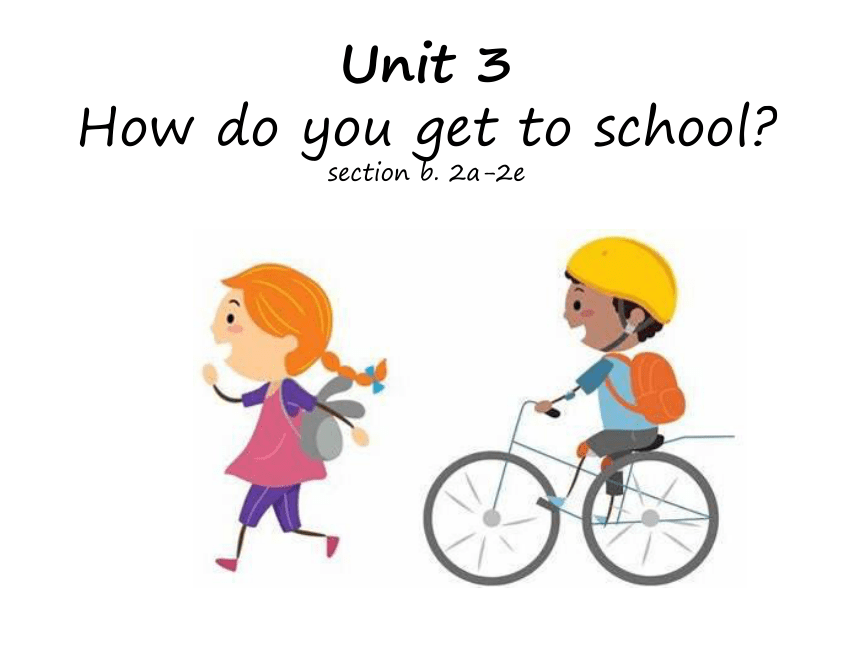
|
|
| 格式 | pptx | ||
| 文件大小 | 4.5MB | ||
| 资源类型 | 教案 | ||
| 版本资源 | 人教新目标(Go for it)版 | ||
| 科目 | 英语 | ||
| 更新时间 | 2022-03-11 16:37:41 | ||
图片预览

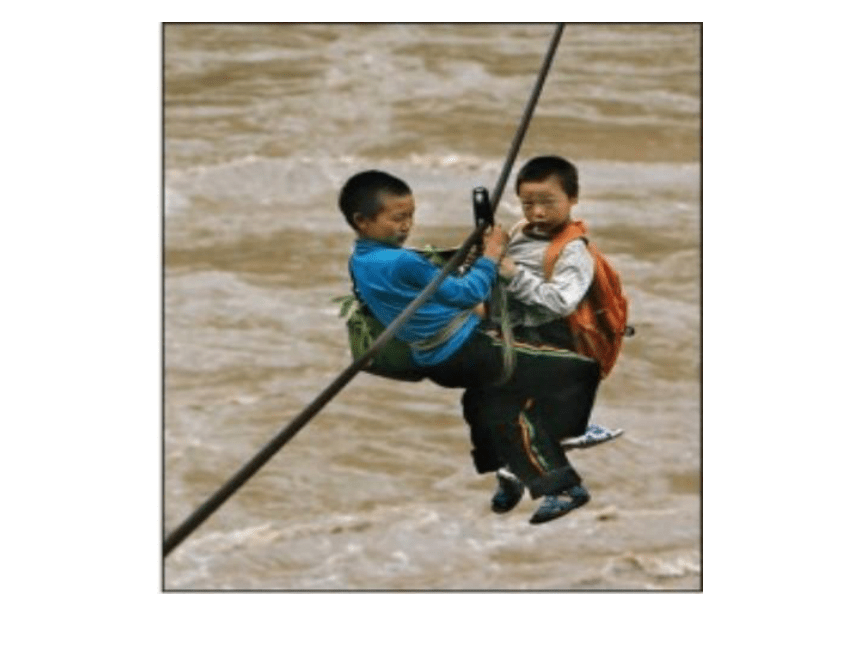
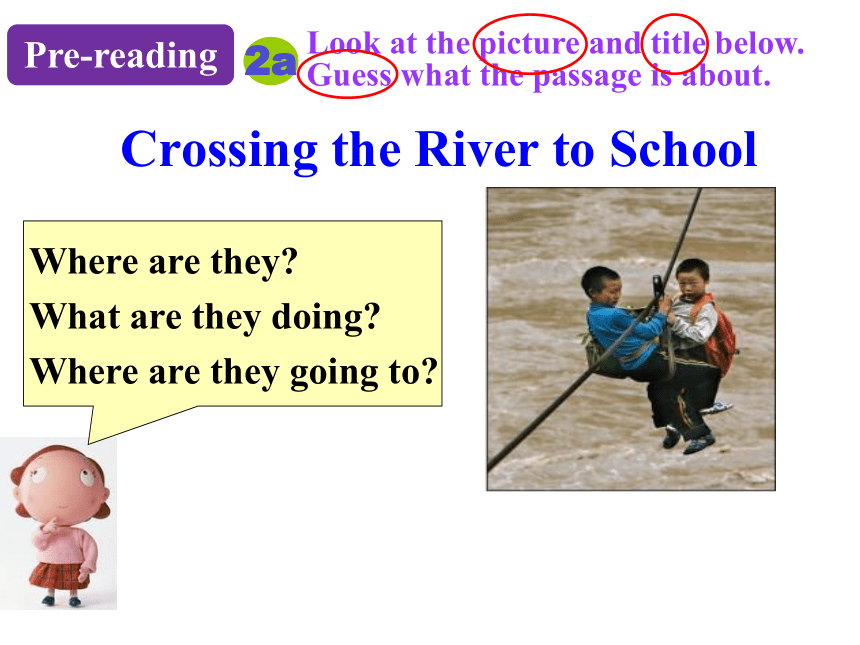
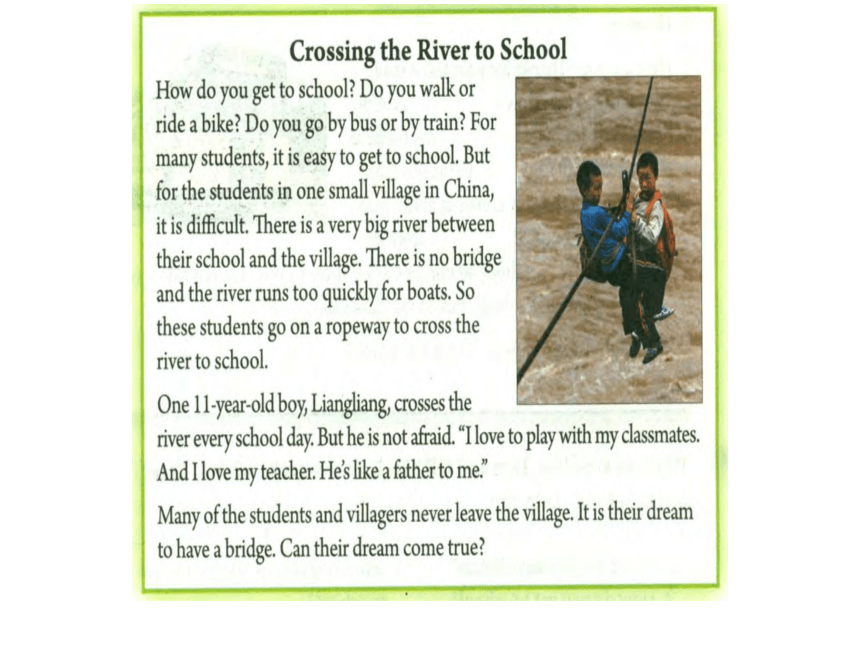
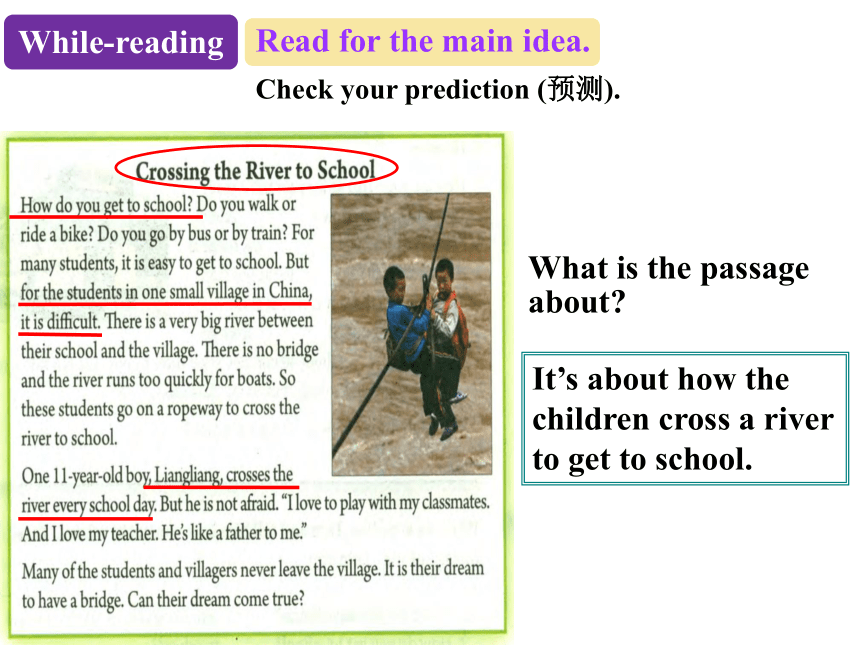
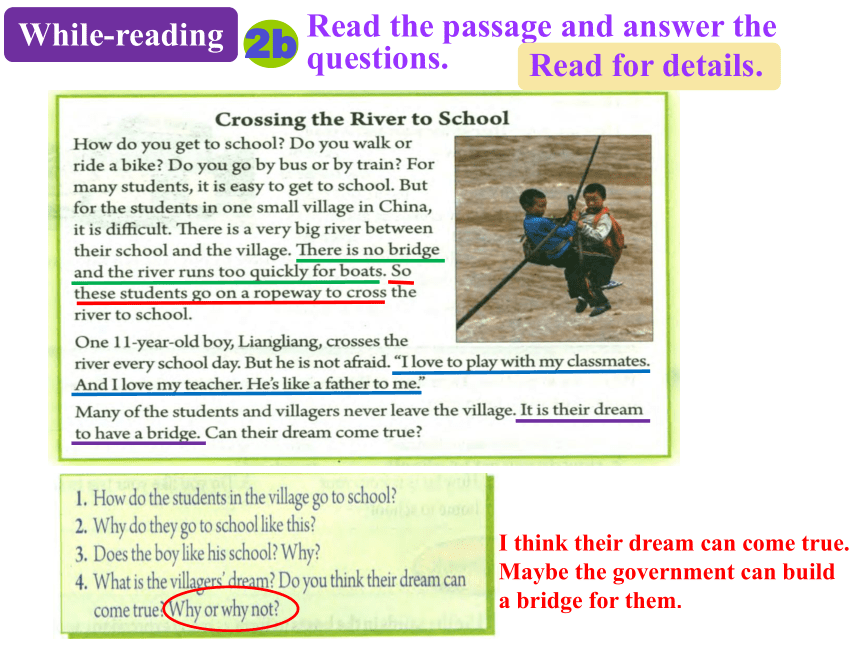
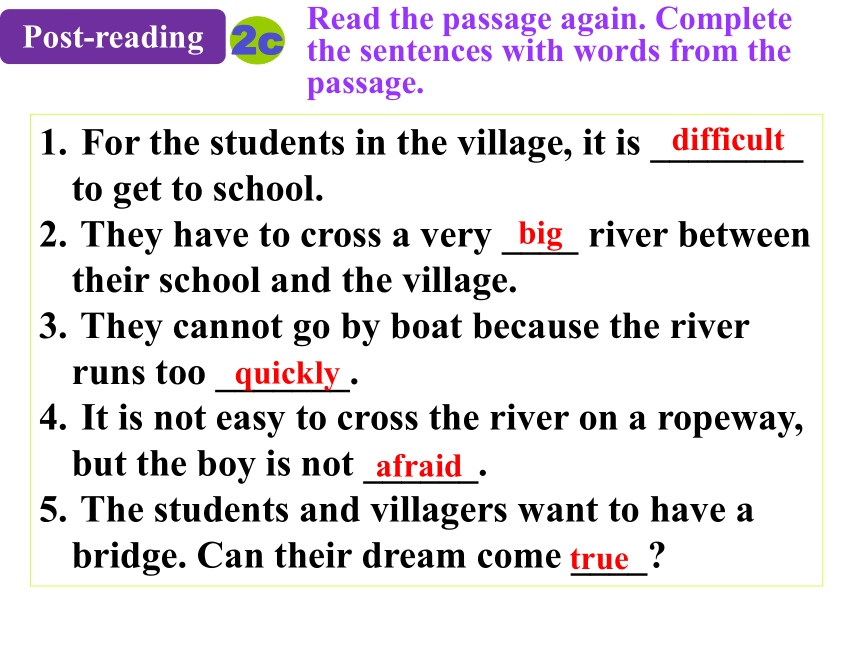
文档简介
(共18张PPT)
Unit 3
How do you get to school
section b. 2a-2e
2a
Look at the picture and title below. Guess what the passage is about.
Crossing the River to School
Where are they
What are they doing
Where are they going to
Pre-reading
While-reading
It’s about how the children cross a river to get to school.
Read for the main idea.
Check your prediction (预测).
What is the passage about
While-reading
2b
Read the passage and answer the questions.
Read for details.
I think their dream can come true. Maybe the government can build a bridge for them.
For the students in the village, it is ________ to get to school.
They have to cross a very ____ river between their school and the village.
They cannot go by boat because the river runs too _______.
It is not easy to cross the river on a ropeway, but the boy is not ______.
The students and villagers want to have a bridge. Can their dream come ____
difficult
big
quickly
afraid
true
2c
Read the passage again. Complete the sentences with words from the passage.
Post-reading
Post-reading
Read the passage after the tape. Ask questions.
Post-reading
After reading this passage, what is your feeling
1. We are lucky to study in the city.
2. We should cherish what we have and study hard.
3. Try our best to help students in poor areas.
4. ...
Post-reading
After reading this passage, what is your feeling
1. We are lucky to study in the city.
2. We should cherish what we have and study hard.
3. Try our best to help students in poor areas.
4. ...
Pair-work
Student A is an interviewer, student B is Liangliang,
use the information in the passage to make a conversation
Review
1. cross the river to school
2. be (not) afraid
3. …it is easy to get to school.
4. There is a very big river between their school and the village.
5. come true
6. There is no bridge and the river runs too quickly for boats.
7. go on a ropeway to cross the river to school
8. One 11-year-old boy, Liangliang, crosses the river every school day.
9. The bus ride is never boring because…
10. It is their dream to have a bridge.
1. Look! There are some boats in the r________.
2. Tony likes reading and he has m_____ books.
3. Mr. Hu is my favorite teacher. He’s l_____ a father to me.
4. I’m a______ Ms. Li is not at home now.
5. It’s 6:30 p.m. It’s time to go home. I must l____ now.
Ⅰ. 根据句意及首字母提示完成单词。
iver
any
ike
fraid
eave
1. 他家离汽车站不远。
His home is not ____ _____ the bus
station.
2. 桌子上有一个杯子。
______ ____ a cup on the desk.
3. 我喜欢和我的狗狗玩。
I love to _____ _____ my dog.
4. 我希望你的梦想能早日实现。
I hope your dream can _____ ____ soon.
far from
play with
come true
There is
Ⅱ. 根据汉语意思完成英语句子,每空一词。
1. 对许多学生来说,到校上学实属易事。
2. 在他们村子和学校之间有一条很大的河。
3. 亮亮,一个11岁男孩,每天过河上学。
4. 他们的梦想能够实现吗?
Ⅲ. 翻译下列句子。
For many students, it is easy to get to school.
There is a very big river between their school and the village.
Can their dream come true
One 11-year-old boy, Liangliang, crosses the river every school day.
Homework
Write down the conversation you made in class.
Teaching Goals
(教学目标)
知识与技能:通过本文的阅读教学,重视对学生阅读能力的培养,包括预测语篇信息,理解文章细节内容,对信息进行加工的策略。另外,以词块的方式进行文章深入的理解和把握。
思维品质:用Where are they going to 提问,培养学生的联想能力;通过头脑风暴,学生开放性地表达自我观点、提高发散思维。
学习策略:1.训练学生阅读中抓取关键信息的能力;2.训练学生通过图片和标题预测文章大意、猜测单词意思的能力。
情感态度:了解偏远山区孩子上学的艰苦,唤起城市孩子的关注,懂得珍惜当下。培养学生换位思考的品质。
Analysis of Teaching Materials
(教材分析)
2a:读前活动,通过标题和图片进行预测。
2b:通过几次不同目的的读,归纳文章主旨、理解文章细节;通过开放式问题的设置,检测理解情况。同时学生读后及时生成,并能自由表达观点。
2c:理解文段内容及细节、学习语言知识。
各环节之间的联系:
读前预测→读中运用阅读策略了解文章细节→读后语言输出
Unit 3
How do you get to school
section b. 2a-2e
2a
Look at the picture and title below. Guess what the passage is about.
Crossing the River to School
Where are they
What are they doing
Where are they going to
Pre-reading
While-reading
It’s about how the children cross a river to get to school.
Read for the main idea.
Check your prediction (预测).
What is the passage about
While-reading
2b
Read the passage and answer the questions.
Read for details.
I think their dream can come true. Maybe the government can build a bridge for them.
For the students in the village, it is ________ to get to school.
They have to cross a very ____ river between their school and the village.
They cannot go by boat because the river runs too _______.
It is not easy to cross the river on a ropeway, but the boy is not ______.
The students and villagers want to have a bridge. Can their dream come ____
difficult
big
quickly
afraid
true
2c
Read the passage again. Complete the sentences with words from the passage.
Post-reading
Post-reading
Read the passage after the tape. Ask questions.
Post-reading
After reading this passage, what is your feeling
1. We are lucky to study in the city.
2. We should cherish what we have and study hard.
3. Try our best to help students in poor areas.
4. ...
Post-reading
After reading this passage, what is your feeling
1. We are lucky to study in the city.
2. We should cherish what we have and study hard.
3. Try our best to help students in poor areas.
4. ...
Pair-work
Student A is an interviewer, student B is Liangliang,
use the information in the passage to make a conversation
Review
1. cross the river to school
2. be (not) afraid
3. …it is easy to get to school.
4. There is a very big river between their school and the village.
5. come true
6. There is no bridge and the river runs too quickly for boats.
7. go on a ropeway to cross the river to school
8. One 11-year-old boy, Liangliang, crosses the river every school day.
9. The bus ride is never boring because…
10. It is their dream to have a bridge.
1. Look! There are some boats in the r________.
2. Tony likes reading and he has m_____ books.
3. Mr. Hu is my favorite teacher. He’s l_____ a father to me.
4. I’m a______ Ms. Li is not at home now.
5. It’s 6:30 p.m. It’s time to go home. I must l____ now.
Ⅰ. 根据句意及首字母提示完成单词。
iver
any
ike
fraid
eave
1. 他家离汽车站不远。
His home is not ____ _____ the bus
station.
2. 桌子上有一个杯子。
______ ____ a cup on the desk.
3. 我喜欢和我的狗狗玩。
I love to _____ _____ my dog.
4. 我希望你的梦想能早日实现。
I hope your dream can _____ ____ soon.
far from
play with
come true
There is
Ⅱ. 根据汉语意思完成英语句子,每空一词。
1. 对许多学生来说,到校上学实属易事。
2. 在他们村子和学校之间有一条很大的河。
3. 亮亮,一个11岁男孩,每天过河上学。
4. 他们的梦想能够实现吗?
Ⅲ. 翻译下列句子。
For many students, it is easy to get to school.
There is a very big river between their school and the village.
Can their dream come true
One 11-year-old boy, Liangliang, crosses the river every school day.
Homework
Write down the conversation you made in class.
Teaching Goals
(教学目标)
知识与技能:通过本文的阅读教学,重视对学生阅读能力的培养,包括预测语篇信息,理解文章细节内容,对信息进行加工的策略。另外,以词块的方式进行文章深入的理解和把握。
思维品质:用Where are they going to 提问,培养学生的联想能力;通过头脑风暴,学生开放性地表达自我观点、提高发散思维。
学习策略:1.训练学生阅读中抓取关键信息的能力;2.训练学生通过图片和标题预测文章大意、猜测单词意思的能力。
情感态度:了解偏远山区孩子上学的艰苦,唤起城市孩子的关注,懂得珍惜当下。培养学生换位思考的品质。
Analysis of Teaching Materials
(教材分析)
2a:读前活动,通过标题和图片进行预测。
2b:通过几次不同目的的读,归纳文章主旨、理解文章细节;通过开放式问题的设置,检测理解情况。同时学生读后及时生成,并能自由表达观点。
2c:理解文段内容及细节、学习语言知识。
各环节之间的联系:
读前预测→读中运用阅读策略了解文章细节→读后语言输出
同课章节目录
- Unit 1 Can you play the guitar?
- Section A
- Section B
- Unit 2 What time do you go to school?
- Section A
- Section B
- Unit 3 How do you get to school?
- Section A
- Section B
- Unit 4 Don't eat in class.
- Section A
- Section B
- Unit 5 Why do you like pandas?
- Section A
- Section B
- Unit 6 I'm watching TV.
- Section A
- Section B
- Review of Units 1-6
- Unit 7 It's raining!
- Section A
- Section B
- Unit 8 Is there a post office near here?
- Section A
- Section B
- Unit 9 What does he look like?
- Section A
- Section B
- Unit 10 I'd like some noodles.
- Section A
- Section B
- Unit 11 How was your school trip?
- Section A
- Section B
- Unit 12 What did you do last weekend?
- Section A
- Section B
